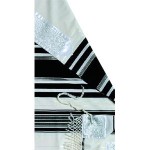If you step into a traditional Orthodox shul anywhere in the world or visit the Western Wall at Shacharit time, you’ll see the traditional wool tallit draped down the back of dozens of men. They may all look pretty much the same, but upon closer scrutiny a number of distinctions come to light.
Some of the variations on the classic black-on-white wool tallit include Yemenite tallits, Sephardic tallits, Turkish tallits, Chabad tallits and more.
The Sephardic Tallit
The Sephardic tallit often features white striping rather than black striping and the tzitzits are sometimes tied differently, based on Kabbalah. Some Sephardim have a stringency of ensuring the tallit is 100% wool – including the atara and the corners. The latter type is commonly known as the Beit Yosef tallit.
The Yemenite Tallith

The traditional Yemenite tallit is an elaborate affair. The atara is wider and is decorated with silver or gold threads, as are the corner reinforcements. The striping pattern is distinct from the typical Ashkenazi custom. The tzitzit of a Yemenite tallit are sometimes tied according to the Rambam. And most notable of all perhaps, are the netted fringes.
The Chabad Tallis
The tzitzit on the Chabad tallit, like the Yemenite and Sephardic tallit, is tied according to a special custom (“chulyot“). According to Chabad the tzitzit are attached to two holes in each corner. (The custom among most Chassidim is to use two holes in the tallis katan, but not in the tallis gadol.) Also, the corners of the Chabad tallit are lined with genuine silk, though the tallit itself is wool.
The Turkish Tallit
The Turkish tallit is not from Turkey, but from Tunisia. During the 19th century, when Tunisia was under Ottoman rule (hence the name “Turkish”), a Turkish sultan banned linen from the country. These wool tallits soon became prized because there was no chance of them containing shatnez. Made from a dense weave, the Turkish tallit is the heaviest wool tallit available. It also features unique two-knotted fringes. A variation on the Turkish tallit is the Kmo tallit, which is made of a somewhat lighter woolen weave.
Besides these specialized tallits, certain features can be noted among standard Ashkenazi wool tallits, though they are not readily apparent. Occasionally you will see techelet in the tzitzit. And although there is no way to detect it, the tzitzit can be of various levels of hiddur (halachic improvements). Rather than machine-spun the tzitzit may be hand-spun, or what is known as “niputz lishma” and “lashonos.”
Traditional Tallits
Classic Wool Tallits>>
Turkish and Kmo>>
Yemenite>>
Chabad>>
Sephardic>>

